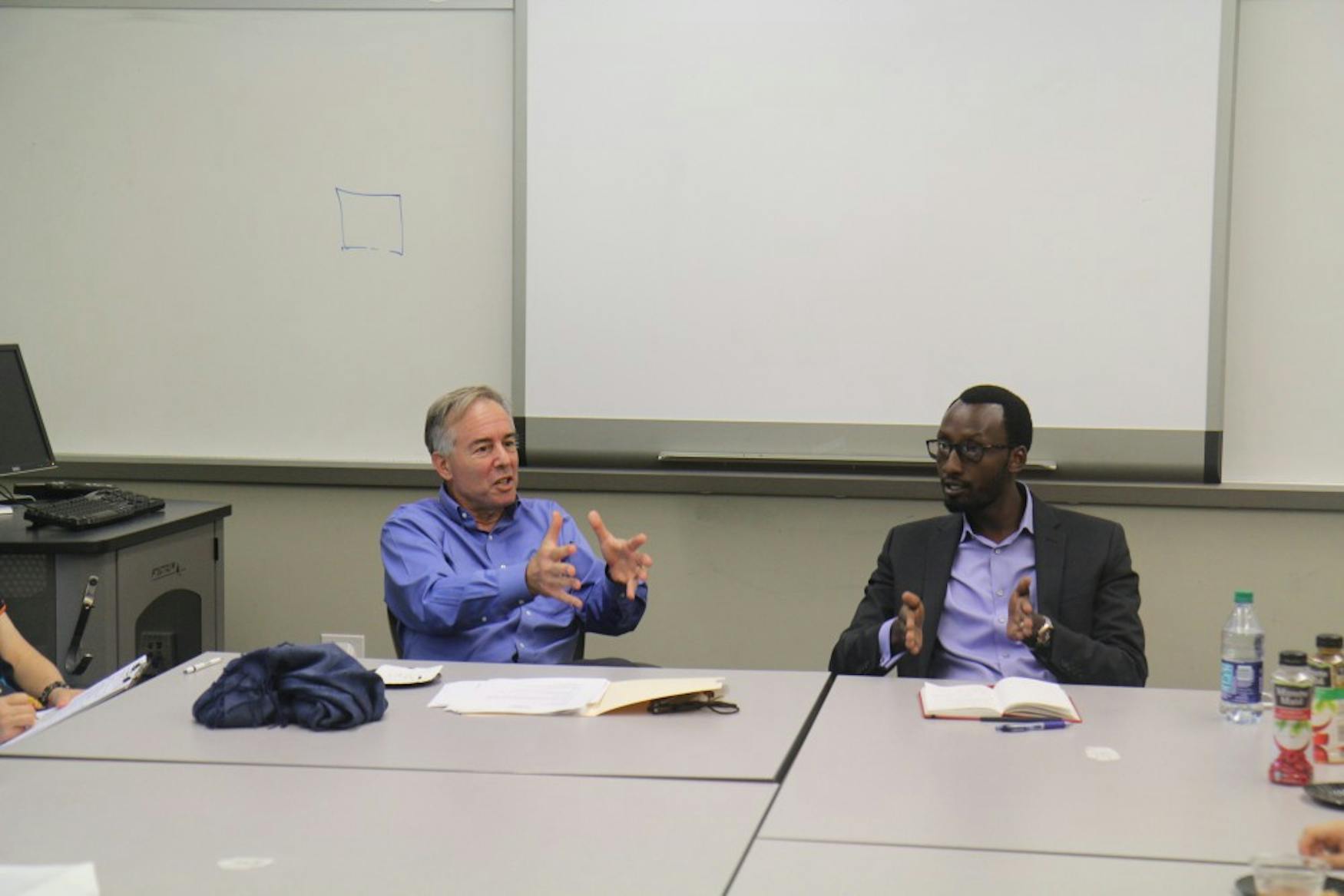Rwandan genocide survivor Pacifique discusses experiences
Bonheur Pacifique can give you directions to where the people who killed his family live today. He knows where a pastor, who once refused to protect him due to protecting too many children already, is living now in Rwanda, Pacifique’s home country. On Thursday, he spoke to a group of students and professors about the long history leading up to the 1994 Rwandan genocide, his own experience of the event as a child and the struggles Rwanda now faces in the aftermath.
The event was an open session of PAX 89: Internship in Peace, Conflict and Coexistence Studies. Prof. Daniel Terris (PAX), who is also the director of the International Center for Ethics, Justice and Public Life, hosted the event and helped lead the discussion with Pacifique, who is a guide at the Kigali Genocide Memorial Centre, a non-profit organization that includes a museum, a memorial and ongoing research into the Rwandan genocide.
Terris introduced Pacifique as “someone who both himself has experienced one of the truly horrific events of our time, but also is very much involved, and centrally involved, in the continuing process of rebuilding his country.”
Pacifique and Terris began the discussion with an overview of the history leading up to the Rwandan genocide. Before being colonized by Belgium in the early 1900s, Rwandan culture did not have major social differences among its inhabitants. But when Belgian colonial forces entered the country, they identified and created three distinct races for the people: Hutus, Tutsis and Twas. While certain differences between the groups were created — including height, nose size and number of cows one owned — Pacifique described the differences between Hutus, Tutsis and Twas as “social and colonial classes.”
The King of Rwanda, though only a figurehead, according to Pacifique, was a Tutsi. The Tutsi population held many positions of power, despite making up only 15 percent of the population, compared to the Hutu majority of 84 percent, according to Pacifique.
In 1959, the Rwandan king was killed, and an early wave of anti-Tutsi sentiment led to many Tutsi either fleeing or being killed by Hutus. Over the following years, the Rwandan government continued to emphasize the differences between Hutus and Tutsis.
Eventually, in the early 1990s, some of the Tutsis who fled Rwanda in the 1950s returned and began a violent uprising in the country, calling themselves the Rwandan Patriotic Front. In response, the Rwandan government mobilized the country’s media and schools to spread anti-Tutsi propaganda, comparing Tutsi to cockroaches and other vermin.
“People began to understand that killing a Tutsi would never cause any sort of remorse,” Pacifique explained. “Because they are not human beings first, and they are a threat to the nation and a threat to the person [killing them]. So you need to react, right?”
Pacifique then discussed his own experiences of the Rwandan genocide. He was six years old when the event began in April 1994. “I guess if I heard about the word[s] Hutu, Tutsi or Twa, it was not more than five times in my family. Of course, we were Tutsi,” Pacifique said.
One Saturday, Pacifique’s parents took him and his other family members to a neighbor’s home, without explaining why. That night, he heard houses being destroyed and people running. A few days later, a woman ran into Pacifique’s home and simply said, “They’re coming.”
Pacifique’s mother brought him to a neighboring family’s home, then left, which was the last time he ever saw her. The woman who protected him was named Marianna, and Pacifique referred to her in the talk as both his “savior” and his “book” for remembering what happened to him.
According to Terris, the origins of the genocide campaign are still being debated, but it was a highly organized and systematic campaign that led to 800,000 deaths within a few months.
Because so many people were involved as both perpetrators and victims, Terris said “one of the challenges of the aftermath [is] that this affected just about every family in the country in one way or another.”
Pacifique finally spoke about the importance of remembering the event rather than trying to forget it or deny it. In his opinion, the best thing which the government has done since the genocide is abandon the terms “Hutu,” “Tutsi” and “Twa.” “I know where the people who killed my family are. It’s difficult for me, but it’s true that I’m trying to find that balance,” Pacifique said.
Students then asked Pacifique about his opinions on programs the government has instituted in response to the event.
He responded that while he was initially skeptical towards many of the programs due to their political nature, he has been touched to see perpetrators and victims visit the memorial together during his work as a guide. He said that the country still has a long way to go, but that he feels hopeful about programs that encourage perpetrators and victims to live together and do business together. He also hopes that more and more Rwandans will become comfortable and willing to talk about the genocide and its legacy in their lives.
“It’s a simultaneous effort to build bridges and eliminate distinctions in the name of a Rwandan identity,” Terris said.



Please note All comments are eligible for publication in The Justice.